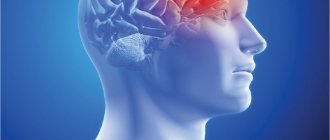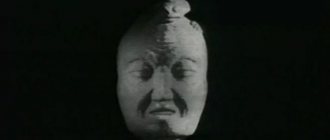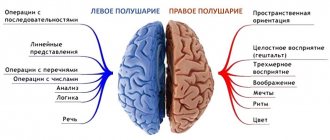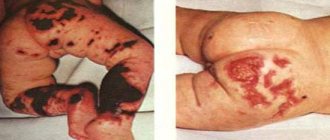There is injury, no symptoms
How can you tell if you have a TBI if you haven’t lost consciousness?
Alexander Borovsky:
— As for injuries in adults (it’s different with children), if a person hits his head so hard that he gets a TBI, he usually loses consciousness. He may not even notice that he has “passed out.” If a person loses consciousness even for a few seconds and/or has nausea and vomiting, with the presence of a head injury, this is a sign of at least a mild TBI. Regardless of the severity, patients with such injuries should be observed in a hospital. Why is it important? Due to possible delayed deterioration of the patient's condition.
The period of imaginary well-being, before the development of secondary symptoms, is called the light interval. A vessel in the head is torn or a small fracture occurs that is not felt, there is no external damage. This is likely if, for example, the victim was wearing a helmet or hat at the time of the accident. Bleeding leads to the formation of an intracranial hematoma and can cause delayed compression of the brain. In this case, the person loses consciousness not from the concussion, but from compression and dislocation of the brain. Here a person will no longer regain consciousness without outside help. If they manage to get him to the hospital and undergo surgery, he will be lucky.
If you still don’t go to the hospital, will such injuries make themselves known in the future?
— The consequences of severe TBI can be compared with the consequences of a stroke. Severe TBI often results in neurological impairment. To regain lost functions, patients will need long-term rehabilitation.
Timely treatment of moderate TBI helps to restore lost functions within a month. Ignoring symptoms can lead to disability.
A single mild traumatic brain injury goes away without consequences after an average of a week, but repeated concussions are dangerous. This is especially true for boxers, because a knockout is at least a concussion. Athletes endure quite a lot of them during their lives. Gradually accumulating, brain damage ultimately leads to dementia, which manifests itself clinically in the form of absent-mindedness and focal neurological symptoms. When we hospitalize a patient with a mild TBI, he is not so much treated as he is monitored so that the minor injury does not develop into a severe one. And for recovery, by and large, only psycho-emotional peace and sometimes painkillers are needed.
Causes of brain injuries
Various mechanisms lead to brain damage. Doctors divide these mechanisms into several subtypes depending on the type of brain damage.
- Traumatic brain injuries can have the following causes: penetrating, blunt trauma to the skull.
- Infectious diseases have the following causes: pathogenic agents (viruses, bacteria, parasites, fungi).
- Malignant lesions have the following causes: primary and secondary brain lesions.
- Benign lesions have the following causes: Abnormally growing cells in the brain.
- Vascular lesions of the brain may have the following causes: weakening of the vascular walls; abnormal growth of blood vessels in the brain; strokes.
- Genetic lesions have the following causes: defects in DNA.
- Immune diseases have the following causes: development of scar tissue; attacks by the immune system on components of the brain.
- When brain cells die, the following reasons are identified: defects in brain cells; death of brain cells; genetics; toxic substances.
- When plaques form, the following causes appear: the accumulation of certain materials in the brain.
- The development of brain damage from ionizing radiation is influenced by: gamma rays; X-rays; other types of radiation.
Chronic hematoma in the elderly
Any bruising gradually disappears as the hematoma resolves. Why does an acute hematoma in the cranial cavity sometimes become chronic?
Alexander Borovsky:
— Chronic hematoma can be a consequence of traumatic brain injury, this is more common in older people. For example, a person slightly hit his head and forgot about this incident. After 10-14 days, the hematoma becomes chronic.
In older people, over the years, the volume of the brain becomes less than the intracranial volume, and many free cerebrospinal fluid spaces appear. After injury, minor bleeding does not lead to compression of the brain, so an asymptomatic course is possible. Over time, the blood breaks down into its components. Fibrin, which is contained in the blood, falls out, forming a capsule around the hematoma. The capsule works like a semi-permeable membrane, then red blood cells are destroyed and large protein molecules are released. Along an osmotic gradient, water from the surrounding tissues begins to flow into the hematoma cavity.
Another danger is an increase in the volume of the hematoma due to new hemorrhages from the newly formed vessels of the capsule. When it grows strongly (2-3 cm thick and can be more than 300 ml in volume), symptoms arise, for example, a headache appears, an arm or leg fails, speech and consciousness are impaired.
By the way, there are other factors that contribute to the formation of chronic hematomas: taking anticoagulants, vascular diseases, etc.
TBI in children has its own characteristics
Today in Minsk, children’s traumatic brain injuries are dealt with by specialists from the Republican Scientific Research Center of Neurology and Neurosurgery; until 2010, young patients were also admitted to the Emergency Hospital, which had a children’s neurosurgical department.
The reaction of a child’s body to injury differs from the reaction of an adult due to the anatomical and physiological characteristics of the brain and skull in childhood. Clinical manifestations of TBI are sometimes subtle.
Very young children cannot complain about where it hurts or describe symptoms, so it is difficult to collect an anamnesis. Doctors can only rely on the mother or other witnesses to the injury. If a child under the age of one year has a head injury, even if he fell from a small height and the mother thought the blow was insignificant, the child must be seen by a doctor. Children under 3 years of age are hospitalized together with their mother.
Some people mistakenly believe that children are more susceptible to TBI because of their immature skull, which has not yet ossified. This is wrong. Babies' brains are very hydrophilic, sensitive to shock, bruises and concussions. The fontanel and unformed bone sutures in no way protect against increased intracranial pressure during injury.
Parents need to pay attention to the following symptoms after a head injury: changes in behavior (become lethargic, drowsy, strange), nausea, vomiting, headache, dizziness, convulsions, especially bleeding or discharge of clear fluid from the ear or nose, bruises under the eyes. Symptoms may occur immediately or within 24 hours.
Notice when the baby cried: immediately or some time after the fall. If you did not see the moment of injury with your own eyes, you may have missed the time of loss of consciousness and may not even be aware of the TBI. It is important to monitor the child’s appetite and activity after an injury. Any of the above symptoms is a reason to immediately consult a doctor.
Where to go if you have a TBI
If there is a wound on the head, you need to contact a surgeon to stitch it up, and he should already determine whether a CT scan and consultation with a neurosurgeon are necessary. If there is no wound, but you are worried about vomiting or other symptoms of a traumatic brain injury, we turn to a neurosurgeon, or in regional hospitals to a neurologist, traumatologist or surgeon.
According to instruction No. 1110 on the procedure for organizing the provision of medical care to patients with traumatic brain injury, such care is provided in stages: at the pre-hospital stage; in the emergency department of hospital healthcare organizations; in specialized neurosurgical departments of regional, city and interdistrict hospitals, in surgical and trauma departments with assigned beds for the treatment of patients with TBI in regional, city, interdistrict and district hospitals; in intensive care wards and anesthesiology and intensive care departments of regional, city, interdistrict and district hospitals.
All patients with mild TBI should be hospitalized. If it is not possible to do a CT scan, it is necessary to observe them in a hospital for at least 5 days.
Computed tomography of the brain is the main method for studying patients with TBI. It allows you to identify intracranial hematomas and hemorrhagic stroke, exclude a tumor or, for example, an ischemic stroke.
What if the victim refuses hospitalization?
Alexander Borovsky:
— A patient’s refusal to hospitalize for a brain injury has no legal force. The victim may be in an inadequate state, unable to make the right decision, and not understand the full danger of refusing hospitalization for his health. And the doctor has no right to force him to hospitalization if the patient is conscious and refuses medical care. We do not force hospitalization. We are trying to explain as clearly as possible what threatens him. Perhaps through relatives. If the patient leaves without permission, we transfer the asset to the clinic at the place of residence, and sometimes we turn to the police for help.
When is a patient with a TBI brought to the hospital reported to law enforcement?
If there is a suspicion of a criminal nature of the injury, it is mandatory to report to law enforcement agencies. If the patient arrives unconscious and it is impossible to find out the circumstances under which the injury was sustained, a report is also sent to the police. We report patients injured in road accidents to the traffic police.
Whiplash neck injury
Typically, the safest place in a car is the seat behind the driver. A child seat is most often placed here and older people and women are seated here. But, despite the relative safety, even there you need to be securely fastened.
Most common injury
The fact is that in an accident, when one car crashes into another from behind, or during heavy braking, passengers in the back seat experience a two-stage sharp flexion-extension movement in the cervical spine, which can cause traumatic damage to the spinal joints and ligaments , muscles, and sometimes nerve roots. This injury is called whiplash. However, sometimes doctors offer other names - cervicocranial accelerator injury or distortion injury of the cervical spine.
Among patients with whiplash injury, there are 2.5 times more women than men, mostly women 30–50 years old. An explanation could be lower neck muscle strength in females, or perhaps it is because women seek medical help more often.
Even in the absence of obvious injuries to the neck, such an injury can cause long-term neck pain, torticollis, cervicobrachialgia, and headache. These symptoms are often accompanied by dizziness, blurred vision, autonomic symptoms, including erectile dysfunction, persistent moderate neuropsychological disorders, and asthenoneurotic manifestations.
Some experts argue that sometimes whiplash has no consequences and that painful sensations are caused by a complex of psychogenic, psychosocial and social factors, and sometimes are a simple simulation. Previously, the term was even proposed - whiplash neurosis. But due to the development of CT and MRI, injuries to the cervical spine and adjacent organs and tissues have become better diagnosed and, accordingly, better treated.
Whiplash Symptoms
The leading symptoms that almost always accompany whiplash injury are pain in the neck and shoulder girdle, which intensifies when moving the head and arms, accompanied by limited movement in the neck (primarily when bending the head), and dizziness, which is observed at approximately 20–25 % of cases of injury, it can be combined with imbalance.
A headache often occurs, which is often localized in the back of the head, but sometimes radiates to the temple and eye socket. Cochlear (noise, ringing in the ears) and visual (blurred image, blurred vision) disturbances are also characteristic, and paresthesia in the facial area may be observed. In almost a third of cases, nonspecific moderately severe cognitive impairment develops: decreased ability to concentrate, mild memory impairment. Mood changes (anxiety, depression) are often observed. It should be noted that after an injury, the neck very often becomes a zone of psychological fixation. Constant neck pain after injury provokes depression, while anxiety and conversion disorders contribute to chronic pain.







